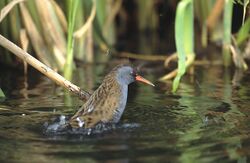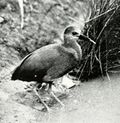Biology:Rallus
| Rallus | |
|---|---|

| |
| Water rail Rallus aquaticus | |
| Scientific classification | |
| Domain: | Eukaryota |
| Kingdom: | Animalia |
| Phylum: | Chordata |
| Class: | Aves |
| Order: | Gruiformes |
| Family: | Rallidae |
| Genus: | Rallus Linnaeus, 1758 |
| Type species | |
| Rallus aquaticus[1] Linnaeus, 1758
| |
| Species | |
|
See list | |
| Synonyms | |
|
Epirallus Miller, 1942 | |
Rallus is a genus of wetland birds of the rail family. Sometimes, the genera Lewinia and Gallirallus are included in it. Six of the species are found in the Americas, and the three species found in Eurasia, Africa and Madagascar are very closely related to each other, suggesting they are descended from a single invasion of a New World ancestor.[2]
These are slim, long-billed rails with slender legs. Their laterally flattened bodies are an adaptation to life in wet reedbeds and marshes, enabling them to slip easily through the dense semi-aquatic vegetation. Typically these birds have streaked brown upperparts, blue-grey on the face or breast, and barred flanks. Only the African rail has a plain back, and the plain-flanked rail lacks any blue-grey in its plumage and has no flank bars.[2]
Three endemic South American species are endangered by habitat loss, and the Madagascar rail is becoming rare.
Taxonomy
The genus Rallus was erected in 1758 by the Swedish naturalist Carl Linnaeus in the tenth edition of his Systema Naturae.[3] The type species was subsequently designated as the water rail (Rallus aquaticus).[4] The genus name Rallus comes from the pre-binomial Latin name Rallus aquaticus for the water rail used by English ornithologist Francis Willughby in 1676,[5] and by the English naturalist Eleazar Albin in 1731.[6] The precise etymology of the word Rallus is uncertain.[7]
Species
The genus contains 14 extant species:[8]
| Image | Common Name | Scientific name | Distribution |
|---|---|---|---|
 |
Ecuadorian rail | Rallus aequatorialis | southwestern Colombia to southwestern Peru. |
 |
Austral rail | Rallus antarcticus | Argentina and Chile. |
 |
Water rail | Rallus aquaticus | Europe, Asia and North Africa. |
 |
African rail | Rallus caerulescens | from Ethiopia to South Africa. |
 |
Clapper rail | Rallus crepitans | eastern U.S., the Gulf of Mexico, eastern Mexico, some Caribbean islands, and south through eastern Central America. |
 |
King rail | Rallus elegans | southern United States and Mexico; in Canada, they are found in southern Ontario. |
 |
Brown-cheeked rail | Rallus indicus | northern Mongolia, eastern Siberia, northeast China, Korea and northern Japan. |
 |
Virginia rail | Rallus limicola | southern United States and Central America. |
| File:Rallus longirostris - 1700-1880 - Print - Iconographia Zoologica - Special Collections University of Amsterdam - UBA01 IZ17500025.tif | Mangrove rail | Rallus longirostris | northeast Colombia, northwest Venezuela ,Brazil, Trinidad |
 |
Madagascar rail | Rallus madagascariensis | Madagascar. |
 |
Ridgway's rail | Rallus obsoletus | southeastern California and southern Arizona, to northwestern Mexico. |
 |
Bogotá rail | Rallus semiplumbeus | Colombia. |
 |
Aztec rail | Rallus tenuirostris | Mexico. |
| Plain-flanked rail | Rallus wetmorei | Venezuela. |
Fossil record
- Rallus sp. (Sajóvölgyi Middle Miocene of Mátraszõlõs, Hungary)[9]
- Rallus sp. (Rexroad Late Pliocene of Saw Rock Canyon, USA)
- Rallus adolfocaesaris Porto Santo rail (prehistoric of Madeira)
- Rallus auffenbergi (Middle Pleistocene of SE North America) – formerly Porzana
- Rallus carvaoensis São Miguel rail (prehistoric of São Miguel Island in the Azores)
- Rallus cyanocavi (Late Pleistocene of the Bahamas)
- Rallus eivissensis, Ibiza rail (prehistoric)
- Rallus ibycus (Shore Hills Late Pleistocene of Bermuda, W Atlantic)
- Rallus lacustris (Late Pliocene of C North America)
- Rallus lowei Madeira rail (prehistoric of Madeira)
- Rallus montivagorum Pico rail (prehistoric of Pico Island in the Azores)
- Rallus nanus São Jorge rail (prehistoric of São Jorge Island in the Azores) - erroneously previously described as Rallus minutus, which is a junior homonym[10]
- Rallus natator (Pleistocene of San Josecito Cavern, Mexico) – formerly Epirallus
- Rallus phillipsi (Late Pliocene of Wickieup, USA)
- Rallus prenticei (Late Pliocene of C North America)
- Rallus recessus (St Georges Soil Late Pleistocene of Bermuda, W Atlantic)
- Rallus richmondi – includes R. dubius
Formerly in Rallus
- "R." arenarius – now Quercyrallus
- "R." beaumontii, "R." dispar – now Pararallus or Palaeoaramides
- "R." christyi, "R." eximius, "R." minor – now Palaeoaramides
- "R." major – now Miorallus
- "R." porzanoides – now Paraortygometra
"R." sumiderensis apparently refers to prehistoric remains of the Zapata rail (Cyanolimnas cerverai).
References
- ↑ "Rallidae". The Trust for Avian Systematics. https://www.aviansystematics.org/4th-edition-checklist?viewfamilies=42.
- ↑ 2.0 2.1 Taylor & van Perlo (1998)
- ↑ Linnaeus, Carl (1758) (in Latin). Systema Naturae per regna tria naturae, secundum classes, ordines, genera, species, cum characteribus, differentiis, synonymis, locis. 1 (10th ed.). Holmiae:Laurentii Salvii. p. 153. https://biodiversitylibrary.org/page/727060.
- ↑ Peters, James Lee, ed (1934). Check-list of Birds of the World. 2. Cambridge, Massachusetts: Harvard University Press. p. 157. https://biodiversitylibrary.org/page/14482970.
- ↑ Willughby, Francis (1676) (in Latin). [249} Ornithologiae libri tres]. London: John Martyn. p. 234. https://gdz.sub.uni-goettingen.de/id/PPN367579030?tify={%22pages%22:[249]}.
- ↑ Albin, Eleazar; Derham, William (1731). A Natural History of Birds : Illustrated with a Hundred and One Copper Plates, Curiously Engraven from the Life. 1. London: Printed for the author and sold by William Innys. p. 73. https://biodiversitylibrary.org/page/41130459.
- ↑ Jobling, J.A. (2019). "Rallus". in del Hoyo, J.; Elliott, A.; Sargatal, J. et al.. Handbook of the Birds of the World Alive: Key to Scientific Names in Ornithology. Lynx Edicions. https://www.hbw.com/dictionary/definition/rallus. Retrieved 18 July 2019.
- ↑ Gill, Frank; Donsker, David, eds (2019). "Flufftails, finfoots, rails, trumpeters, cranes, limpkin". World Bird List Version 9.2. International Ornithologists' Union. https://www.worldbirdnames.org/bow/flufftails/. Retrieved 8 July 2019.
- ↑ Gál et al. (1998–1999)
- ↑ Alcover, Josep Antoni; Pieper, Harald; Pereira, Fernando; Rando, Juan Carlos (2016-03-01). "Rallus nanus nomen novum: a replacement name for Rallus minutus Alcover et al. 2015". Zootaxa 4085 (1): 141–142. doi:10.11646/zootaxa.4085.1.8. ISSN 1175-5334. PMID 27394294. https://pubmed.ncbi.nlm.nih.gov/27394294/.
References
- Gál, Erika; Hír, János; Kessler, Eugén & Kókay, József (1998–99): Középsõ-miocén õsmaradványok, a Mátraszõlõs, Rákóczi-kápolna alatti útbevágásból. I. A Mátraszõlõs 1. lelõhely [Middle Miocene fossils from the sections at the Rákóczi chapel at Mátraszőlős. Locality Mátraszõlõs I.]. Folia Historico Naturalia Musei Matraensis 23: 33–78. [Hungarian with English abstract] PDF fulltext
- Taylor, P. Barry & van Perlo, Ber (1998): Rails : a guide to the rails, crakes, gallinules, and coots of the world. Yale University Press, New Haven. ISBN:0-300-07758-0
External links
Wikidata ☰ Q220705 entry
 |



